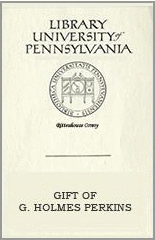Perkins Architectural Rare Book Fund
In 1985, G. Holmes Perkins, HON 1972, established an endowed Library fund for the acquisition of rare books on architecture. The fund and his many gifts have enormously enriched the holdings of Penn's Fisher Fine Arts Library. In 2006, the University of Pennsylvania School of Design established the Perkins Books and Archives Fund, enabling the purchase of rare materials in support of research and teaching. The fund is administered jointly by the Penn Libraries and the School of Design.
Educator, urban planner, and architect, G. Holmes Perkins, Emeritus University Professor of Architecture and Urbanism, remade architectural instruction at Penn in the second half of the 20th century.
Nationally, Dean Perkins' educational leadership earned him election as Chancellor of the College of Fellows of the American Institute of Architects (AIA) in 1964. He received the AIA Medal in 1977 as a "distinguished architect, urban planner, and educator." The text of the award noted his role at Penn, where he "assembled a remarkable faculty which included many of the acknowledged giants of the profession," where "his influence, his guidance, and his vision have been instrumental in developing and nurturing an entire generation of outstanding architects." Finally, the award named him as "a major figure in the development of the design movement known as the Philadelphia School." He was awarded an honorary doctorate in 1972 by Penn for his contribution to Penn. Among the many honors awarded to him, he was especially proud of the Topaz Medallion, the AIA/ASCA Joint Award for Excellence in Architecture Education, which he earned in 1979.
A Harvard graduate, he began his career as an instructor at the University of Michigan, hoping to escape New England for "the freer and more progressive atmosphere of the West." Harvard called him back the following year, however, with an offer to assume the Charles Dyer Norton Professorship of Regional Planning. There he revolutionized the teaching of city planning while initiating the closest collaboration with Walter Gropius' architectural students. Dean Perkins became an active protagonist in the struggle within the profession for a modern architecture and, with Joseph Hudnut and Walter Gropius at Harvard, he fostered the revolution in architectural education that swept the country following WWII.
During World War II, Dean Perkins took a leave of absence from Harvard to work in D.C. with the National Housing Agency; during his final year there, he served as acting director of its Urban Development Division. He returned to Harvard in 1945 as the chairman of the city planning department, where he developed a first-year joint curriculum that brought architecture, landscape and planning departments together in a collaborative venture. He remained at Harvard until he was recruited to head the School of Fine Arts at Penn in 1950.
Upon his arrival at Penn in 1951 as dean, he set about transforming the faculty and the curriculum of the school in the collaborative, progressive image of Harvard's Graduate School of Design. He made sweeping changes in the faculty, bringing in young and talented teachers who would revitalize programs and move away from the Beaux-Arts methods and subjects that had dominated the school since the turn of the century. As an educator, Dean Perkins intended that the graduates of his school enter the professions equipped to make humane environments for urban living. He was confident of modern architecture's capacity to replace the slum, and as an architect of the urban environment, he valued the creation of an environment in harmony with nature.
Soon after he came to Philadelphia, he became one of the key figures in the city's redevelopment and renewal. He served on the board of the Citizens' Council on City Planning, 1953-1955, as president of the Philadelphia Housing Association, 1954-1955, and as chairman of the city's Zoning Advisory Commission, 1956-1958. Most important, he chaired the city's Planning Commission, 1958- 1968. He was also a member of the Philadelphia Development Corporation, 1958-1968, of the Philadelphia Commission on Higher Education, 1953-1968, of the Philadelphia Port Corporation, 1964-1968, and of the Fairmount Park Art Association, for whom he served as trustee for 40 years, 1957-1997.
In retirement, he remained actively involved at Penn through his two passions: the Architectural Archives, which he founded in the late 1970s, and the architectural rare book collection, which he established in 1965.
Dean Perkins was the driving force behind the founding of the Architectural Archives, which preserves over 400 collections from the 18th century to the present. Included are the drawings, models, and records of such designers as Louis Kahn, Frank Lloyd Wright, Mitchell/Giurgola, Edmund Bacon, Ian McHarg, Robert LeRicolais, and Friedrich Weinbrenner.
The rare book room in the Fine Arts Library was named the Perkins Library in 1983 in honor of his work in organizing and developing the rare book collection and his many gifts to enhance it. Housed in the Fisher Fine Arts Library, the Perkins Library is comprised of approximately 2,500 books, with associated prints and maps. Throughout the years of his retirement, he regularly scanned the catalogues of rare book dealers to acquire titles for the collection and created a wonderful legacy for Penn.

